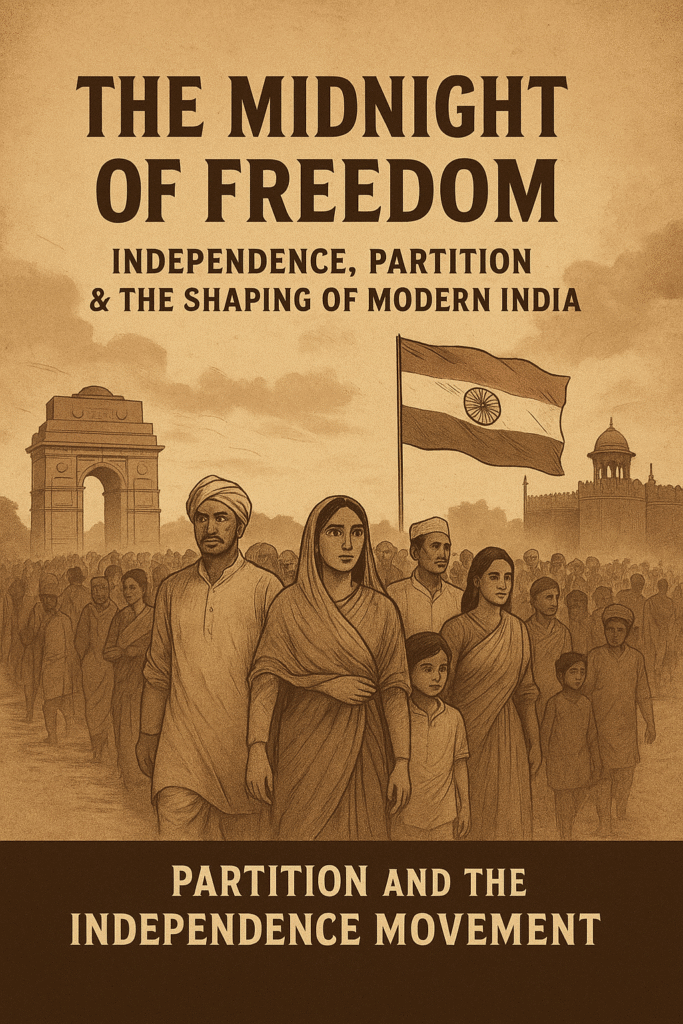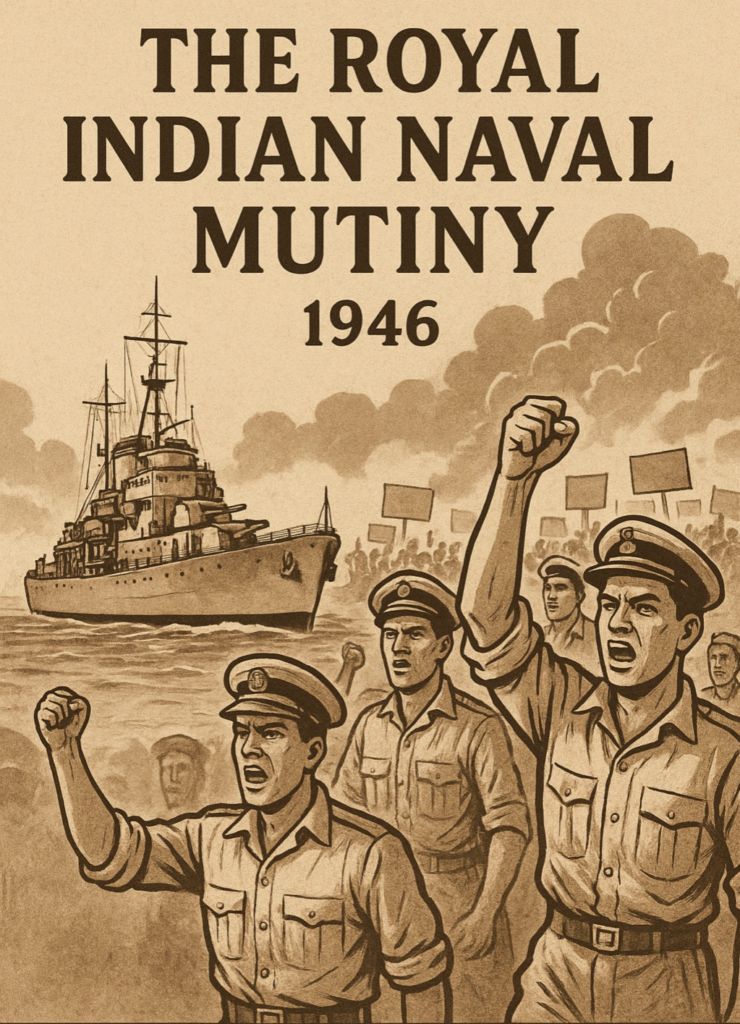Independence, Partition & the Shaping of Modern India
India’s independence in 1947 was the result of decades of struggle, sacrifices and political negotiations. But the freedom that finally came was accompanied by one of the most painful events in our history — the Partition of India.
While the seeds of independence had been sown long before, the final phase — between 1945 and 1947 — was shaped by three major events that decisively pushed the British towards leaving. These events set the stage for the union of India and Pakistan to emerge as two independent dominions.

Event 1 – Britain’s Post-World War Weakness and Changing Political Will
The roots of India’s independence can be traced to the aftermath of World War II. Britain emerged as a victor in 1945 but the war had drained its economy, destroyed much of its infrastructure and diminished its political influence across the world. The empire was financially exhausted with mounting debts to the United States and severe shortages at home.
In the general elections of 1945 Winston Churchill’s Conservative Party — which had resisted Indian independence — was defeated. The Labour Party under Clement Attlee came to power. Attlee’s government had a fundamentally different outlook. They recognised that Britain could no longer afford to maintain large colonial possessions. India, the jewel of the crown was becoming increasingly ungovernable. Their focus shifted from preserving the empire to managing an orderly exit albeit one that still protected British strategic interests.
By early 1947 Attlee’s Government had decided that Britain must leave India without delay. They appointed Lord Louis Mountbatten as the last Viceroy and Governor-General of India with a clear instruction — complete the partition and independence process as quickly as possible even if that meant setting an unrealistic deadline.
Mountbatten advanced the target date for British withdrawal from mid-1948 to August 1947 leaving barely five months to untangle centuries of imperial control and resolve communal disputes that had been building for decades. This accelerated timetable left little room for careful planning. Its consequences would soon be felt in the chaos of partition.
Event 2 – Unrest in the Armed Forces: The Royal Indian Naval Mutiny
If political will in London was shifting, events in India were pushing matters further. The Royal Indian Naval Mutiny of February 1946 became a turning point in Britain’s perception of its ability to govern. This revolt began in Bombay (now Mumbai) when ratings (enlisted sailors) protested against poor conditions, racial discrimination and political repression.
The mutiny quickly spread to other cities like Karachi, Calcutta and Madras involving over 20,000 sailors across 78 ships and shore establishments. Although the mutiny was eventually suppressed, the shock it sent to the British administration was deep. If the armed forces — the very backbone of colonial rule — could rise in open defiance, the possibility of holding India by force seemed increasingly unrealistic. The mutiny also showed unprecedented solidarity among Hindus, Muslims and other communities within the forces, reinforcing the urgency of a negotiated transfer of power.

Event 3 – The Provincial Elections and the Road to Partition
The Indian Provincial Elections of 1946, held just before Mountbatten’s arrival, had already made the political landscape starkly clear. The Indian National Congress swept most general (non-Muslim) seats in provinces like the Central Provinces, United Provinces, Bihar, Orissa and the Madras Presidency reflecting strong public support for a united India.
The All-India Muslim League led by Muhammad Ali Jinnah won almost all Muslim-reserved seats in Punjab, Sindh, Balochistan and significant parts of Eastern Bengal which was taken as a mandate for the creation of Pakistan.
This political reality made partition seem unavoidable. Mountbatten, under orders from London, began moving swiftly to divide the subcontinent.
The Mountbatten Plan and the Radcliffe Line
To draw the borders between India and Pakistan Mountbatten turned to Sir Cyril Radcliffe, an English barrister who had never set foot in India. Radcliffe was given only five weeks to complete the task. He had to balance religious majorities, economic resources and geographical realities but with such limited time and knowledge the final demarcations were bound to be controversial.
The Radcliffe Line sliced through Punjab and Bengal displacing millions overnight. Around 14 million people crossed borders often in dangerous conditions facing violence, loss of property and separation from families.
The Challenge of Integrating the Princely States
While partition dominated headlines, an equally urgent challenge awaited — the political integration of 565 princely states. These semi-autonomous territories were not automatically part of either India or Pakistan. Their rulers were given the choice to accede to one dominion or remain independent.
Sardar Vallabhbhai Patel as Deputy Prime Minister and Minister of Home Affairs along with V. P. Menon his brilliant secretary undertook the herculean task of uniting these states with India. Through diplomacy, persuasion and sometimes pressure they secured the accession of 562 states within months.
Crucial Cases Before Independence
Travancore – Located on the southern tip of India with a strategic coastline on the Indian Ocean, Travancore declared its intention to be an independent nation before India’s independence. Such a precedent could have inspired other states to break away. Patel and Menon acted swiftly, negotiating directly with the Dewan of Travancore and making it clear that independence was neither viable nor acceptable. The state eventually signed the Instrument of Accession before 15th August 1947.
Bhopal – A more dangerous case emerged in central India. The Nawab of Bhopal wished to either remain independent or join Pakistan. For a newly formed India an enemy-aligned state in its geographical center was strategically unacceptable. Patel and Menon engaged in tough negotiations emphasizing the long-term isolation and risks Bhopal would face. Eventually the Nawab relented and Bhopal joined India.
Jodhpur & Jaisalmer – Muhammad Ali Jinnah famously offered the rulers of these states a signed blank document promising to honor any conditions they set if they joined Pakistan. The offer was tempting but Patel personally intervened, using political reasoning and assurances of autonomy within India to secure their accession.
Looking Ahead
While Patel and Menon succeeded in integrating most states, the cases of Junagadh, Hyderabad and Jammu & Kashmir were more complicated and will be elaborated in future blogs.
India’s midnight of freedom was not a single event but a convergence of military unrest, political mandates, hurried decisions and behind-the-scenes diplomacy. It was a moment of triumph intertwined with tragedy — the birth of a nation alongside the trauma of displacement.
In the next chapter (next sunday) “Blog 1.2 – The 1947 Partition: The Political Struggle That Split a Subcontinent” we will examine how early 20th-century political movements, the rise of the Muslim League, communal negotiations, and shifting colonial policies gradually deepened divisions over four decades, ultimately culminating in the Partition of India.
References (Books):
1. The Story of the Integration of the Indian States– V.P. Menon (1956)
2. The Transfer of Power in India – V.P. Menon (1957)
3. Freedom at Midnight — Dominique Lapierre & Larry Collins (1975)
4. The Discovery of India — Jawaharlal Nehru (1946)
5. The Transfer of Power 1942–47 (12 Volumes) — Edited by Nicholas Mansergh
6. Patel: A Life – Rajmohan Gandhi (1990)
7. India After Gandhi – Ramachandra Guha (2007)
References (TV Shows/Movies):
1. Pradhanmantri TV Series- ABP News (2013)
2. Freedom at Midnight- Sony Entertainment Television (2024)